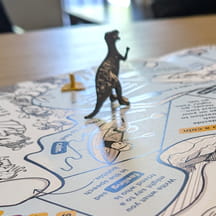Pediatric residents may work 80 hours a week, so engaging them in a children’s hospital’s community health efforts may seem impossible. But building a bridge between community health and future physicians can lead to stronger advocacy, community engagement, and greater public trust.
Jason Yaun, MD, division chief of Outpatient Pediatrics and associate program director of the Pediatric Residency Program at Le Bonheur Children’s Hospital and The University of Tennessee Health Science Center, stresses residents’ important role in community health advocacy. Born and raised in Memphis, he pursued a career taking care of children in his hometown.
“I grew up in Memphis, and I had a very different experience than probably many of the children in our city,” Yaun said. “One day, I just decided to stay here in the heart of Memphis and provide high-quality care to kids who need it, who might not otherwise have that opportunity.”
Yaun addressed Children’s Hospital Association’s Community Health Affinity Group, discussing the value of training pediatric residents to be community health advocates.
What initiatives do you have in place to engage residents in community health?
We know residents are working 80 hours a week, and it can be difficult to gather them. Our team is mindful of their schedules and working around their needs. A committee of community outreach staff, program leadership, communications, and chief residents meet monthly to tap into our residents’ energy. Even if we can get a few of them engaged at any given time, their knowledge can help advance our efforts. They’re the ones with the energy. They may not have the titles or the renown, but they’ve got the passion.
An important part of this work is also training the next generation of physician leaders. Residents receive training in how to interact with the media, conduct themselves on social media, and be physician advocates, including what that looks like for a practicing clinician, how to communicate with legislators and policymakers, and how to harness their experiences and stories for change.
Le Bonheur’s Child Health Advocacy Institute also helps define the gaps in our community and works with community partners on difficult issues impacting children. Hospital leadership, community outreach, government relations, physician leaders, and community organizations collaborate to educate our community and influence policy and legislative change. We’ve been strategic about involving physician leaders because they are often tapped into their national organizations around those issues. They have the knowledge and stories of what they see every day clinically, and we can bring their research and outcomes to these issues.
How do you build community health components into a residency program?
Persistence is key. As residents rotate between the three-year cycles, you have to adjust and adapt as the classes and times change. We have three chief residents per year, and we designate one as the advocacy chief. They are tuned into our community health efforts, consistently attend meetings, provide valuable input, and also translate and provide information on these efforts to their co-residents.
Another constant area of work for us is coordinating how residents can get involved with our programs. For example, if we have a resident who is passionate about swimming safety, they can participate in that program during a lighter rotation. We’ve been successful in integrating these community-based experiences into several of their rotations.
The other approach is to keep them aware of what the hospital is doing. If you are hosting events, programs, or educational sessions, advertise those to your residents. If a couple of residents participate, take your win. It takes time to build those relationships and make residents aware of the great things your hospital is doing.
How do you get longtime physicians involved in the community?
You can engage a physician leader or challenge those who are already involved to invite others into community health initiatives.
Sometimes, especially if you are university-based, part of the physicians’ work includes some type of service. Although it is a small percentage of their work, hold them to that service. This work needs to be measured and recognized. We think about relative value units and educational value units — what about advocacy value units? This work should be valued and understood by both the academic and hospital leadership.
We’ve got to get them to tap into their why. Get them to forget about the phone calls and insurance regulations for a minute and think about the patient and why they went into this profession. Invite them to share a patient encounter or successful collaboration as part of a patient advocacy series or campaign. Patient stories are a great way to remind them why they serve children and get them engaged in the community.
Ultimately, we must encourage resident and physician participation by tapping into their motivations and involving them in community health initiatives through leadership and collaboration.



